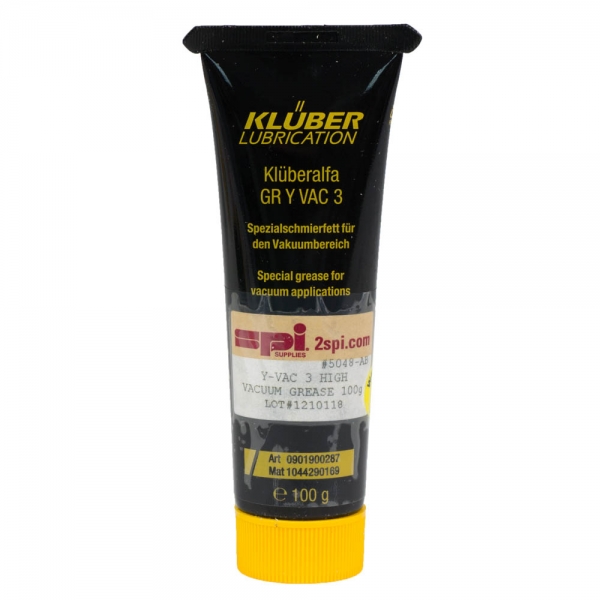Kluberalfa GR Y VAC 3 Grease, 100g tube
Kluberalfa GR Y VAC 3 Grease, 100g Tube
Kluberalpha GR Y VAC 3 is part of the Kluber line of lubrication greases that used to be called Fomblin Y VAC 3. It is a perfluoropolymer based vacuum grease thickened with a PTFE thickener. It is an inert, homogeneous, and white grease particularly suitable for use as a lubricant for mechanical parts or seals operating at high vacuum and in contact with aggressive chemicals or oxygen. GR Y VAC 3 is used in lubricated "for life" applications; its lubricating properties make it suitable for parts requiring boundary (extreme pressure) lubrication in a temperature range from -20°C to 250°C. GR Y VAC 3 is designed to meet MIL-G-27617 Type III specifications and test method ASTM E-595-77 as tested by NASA/GSFC (extremely low outgassing in a vacuum environment). Before making any decision about your vacuum grease requirements, be sure to be aware of some of the other information and specifications concerning GR Y VAC 3 high vacuum grease.
Specifications
| Typical Properties | Klüberalfa GR Y VAC 3 |
|---|---|
| Chemical composition, type of oil | PFPE |
| Chemical composition, solid lubricant | PTFE |
| Lower service temperature | -20°C / -4°F |
| Upper service temperature | 250°C / 482°F |
| Color space | White |
| Texture | Homogeneous |
| Vapor Pressure (Torr) | 20°C (Torr): 4.8x10-13 |
| Density at 20°C | Approx. 1.9 g/cm3 |
| NLGI grade, DIN 51818 | 3 |
| Worked penetration, DIN ISO 2137, 25°C, lower limit value | 220 x 0.1 mm |
| Worked penetration, DIN ISO 2137, 25°C, upper limit value | 250 x 0.1 mm |
| Oil separation, based on ASTM D 6184 [FTMS 791 C 321], after 30 h/200 °C | <= 10 % by weight |
| Evaporation loss, ASTM D 2595 22h/204°C | <= 1 % by weight |
| Minimum shelf life from the date of manufacture - in a dry, frost-free place and in the unopened original container, approx. |
60 months |
Use in Electron Microscopy
For the electron microscope laboratory application, GR Y VAC 3 is widely used because although the liquid component of the grease does eventually evaporate, when it does, the vapors will not. But unlike hydrocarbon based greases, the fluorocarbon nature of the molecular species that will evaporate, will not be polymerized by the ionizing radiation present in the microscope column. Hence, the user of an electron microscope using non-hydrocarbon greases will find in general a cleaner environment and less contamination of samples. For the hydrocarbon greases, when they do evaporate, they are polymerized, and they end up forming a varnish(e.g. contamination) on both microscope parts, apertures, and sampler.
Temperature use range: One can expect the grease to retain its properties pretty much between -20° C to +250° C. Actually, one can use the grease at lower temperatures, but there will be some diminution of at least some of the properties. Clearly, for the electron microscope application, this temperature range will be more than adequate.
Grease Comparison
For those requiring or desiring a grease of ultimate smoothness, that is, one where any agglomerates of the PTFE particles in its formulation have been removed by screen pack filter, one might consider the Braycote Micronic 803 Vacuum Grease. However, for most users, this higher level filtration is probably not necessary and therefore the GR Y Vac 3, and its lower price would be an acceptable alternative.
We are often asked about how GR Y VAC 3 compares with Braycote Micronic 803 in terms of vacuum characteristics. GR Y VAC 3 differs from Braycote Micronic 803 in several respects, including the base oil viscosity, consistency, and the type of PTFE used for the thickener.
The viscosity of the base oil used in GR Y VAC 3 is about 1400 cSt at 20° C whereas the oil used in the formulation of Braycote Micronic 803 is about 250 cSt. GR Y VAC 3 has a NLGI of 3 vs. for Braycote Micronic 803, an NLGI of 2. GR Y VAC 3 is slightly stiffer than the Braycote product. From a chemical composition standpoint, the base oil used for GR Y VAC 3 is a branched perfluorinated polyether, whereas the oil used in the Braycote product is linear. The vapor pressure of GR Y VAC 3 is about 10-13 torr at 20° C. Both greases can be used in vacuum, however, the torque requirements for GR Y VAC 3 would be higher.
For use at low temperatures, for example in conjunction with a cryo stage in an SEM, we would expect that Apiezon N Cryogenic Vacuum Grease should be considered. We believe that the lower temperature properties of the Apiezon N product outweigh any considerations with regard to hydrocarbon off-gassing into the column.
Our intent is to present some of the trade-offs between these different fine grease products. We believe this information to be correct to the best of our knowledge. We cannot guarantee that any prospective vacuum grease solution for a particular problem that is derived from this information will definitely work, so we would urge caution in the final selection and initial use to confirm that any particular grease or grease combination will indeed work for you.
Grease Removal:
The composition of this product is a mixture of small PTFE particles (which won't dissolve in anything) and a perfluorinated polyether liquid. We have found that Castrol Brayco IC X-100 or Perfluorosolv PFS-2 or EnSolv NEXT are effective solvents for the liquid component of the formulated composition and aids in the removal of the grease from places where it is no longer needed or wanted.

